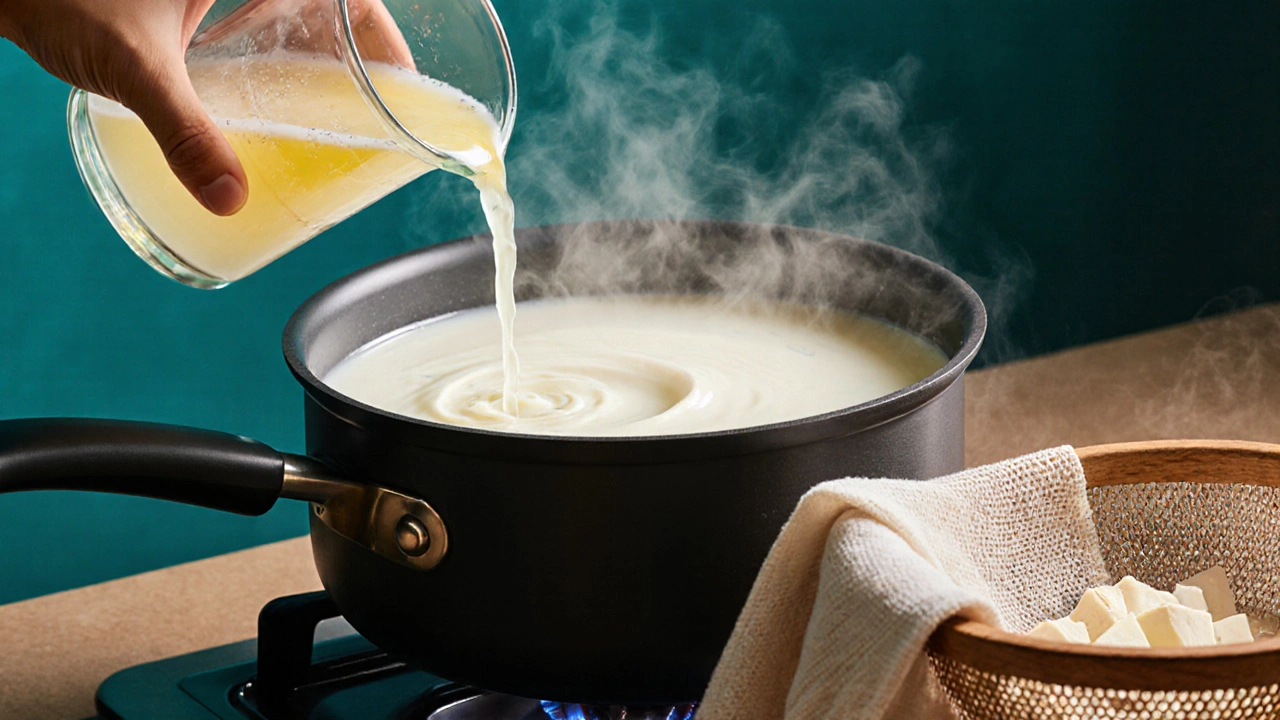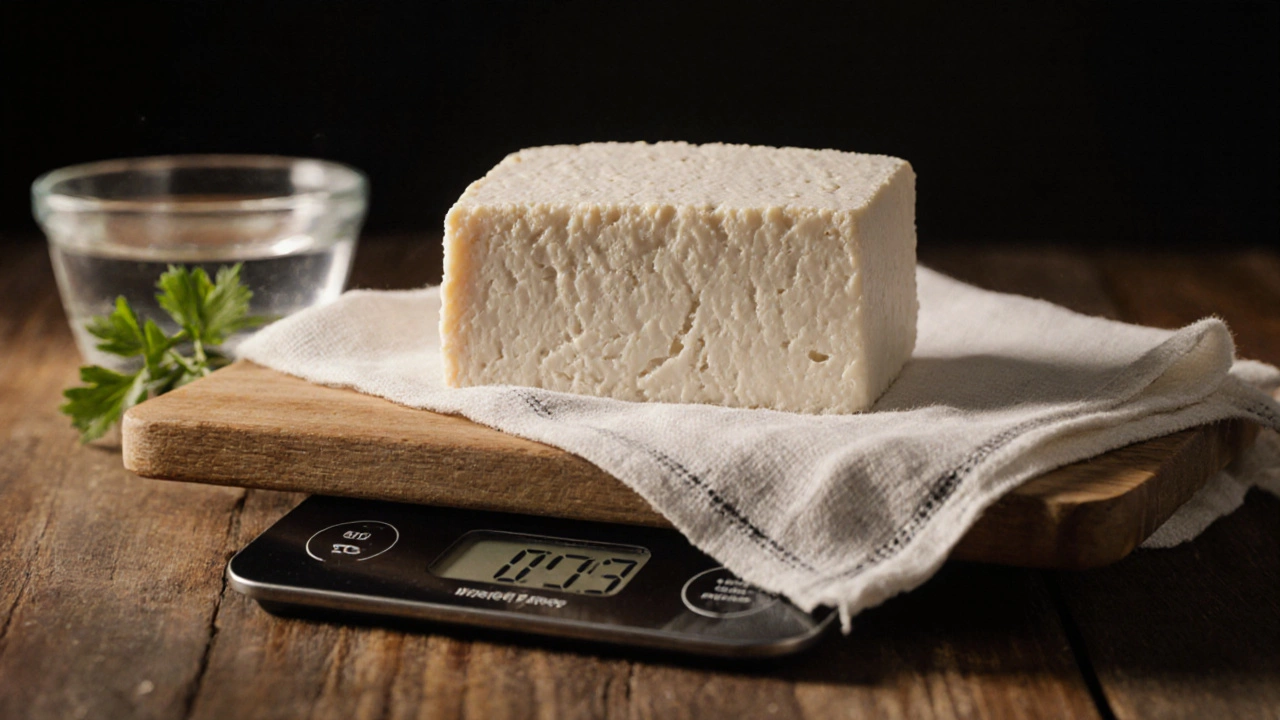Paneer Yield Calculator
Estimated Paneer Yield
Ever wondered how many grams of paneer yield you can squeeze out of a single gallon of milk? Whether you’re budgeting for a big family dinner or just curious about the math behind that fresh cheese you love, this guide breaks down the numbers, the science, and the step‑by‑step process so you can predict your output with confidence.
Key Takeaways
- A gallon of whole milk typically produces 1.2‑1.5 lb (540‑680 g) of paneer.
- Fat content, milk temperature, and type of acid coagulant are the biggest variables.
- Using a cheesecloth and gentle pressing maximizes recovery while keeping texture soft.
- Low‑fat or skim milk will drop the yield by roughly 20‑30% compared to whole milk.
- Accurate measurement of milk volume (US gallon = 3.785 L) is essential for reliable calculations.
Understanding the Central Ingredients
First, let’s define the two core players.
Paneer is a fresh, non‑aged Indian cheese made by curdling heated milk with an acid. It has a neutral flavor, a firm yet crumbly texture, and holds its shape when cooked. Because it’s not aged, paneer retains most of the whey’s moisture, which is why the yield is closely tied to the milk’s water and fat content.
Milk refers to the liquid secreted by mammals; in culinary contexts we usually mean cow’s milk. Its composition includes water (≈87 %), lactose, protein (casein and whey), fat, and minerals like calcium. The standard US gallon equals 3.785 liters, roughly 8 cups.
Why Yield Varies: The Main Factors
- Fat Content: Whole milk (3.5‑4 % fat) yields more paneer because fat is retained in the curd. Skim or 2 % milk loses fat in the whey, reducing mass.
- Acid Coagulant: Lemon juice, vinegar, or citric acid all work, but their strength influences how quickly casein aggregates. A stronger acid can produce tighter curds, trapping slightly more moisture.
- Milk Temperature: Heating to 180‑190 °F (82‑88 °C) denatures proteins optimally. Over‑heating can break down curds, letting more whey escape.
- Pressing Time & Pressure: Gentle pressing (30‑45 minutes) squeezes out excess whey while preserving softness. Heavy, prolonged pressure forces out too much moisture, lowering weight.
- Milk Quality: Fresh milk with higher casein levels (common in grass‑fed cows) creates a denser curd.
Step‑by‑Step Yield Calculation
- Measure the exact volume of milk you’ll use. One US gallon = 3.785 L = 3 ,785 g (since the density of milk is ~1.03 g/mL).
- Determine the fat percentage. For whole milk, assume 3.8 % fat.
- Estimate the proportion of milk solids that become curd. Research and home‑testing show that about 12‑14 % of the milk’s weight ends up as paneer for whole milk.
- Apply the formula:
Paneer weight (g) = Milk weight (g) × Yield factor
Where Yield factor ≈ 0.14 for whole milk, 0.10 for 2 % milk, and 0.07 for skim. - Adjust for losses during straining and pressing (usually 5‑10 % of the curd weight). Subtract that to get the final usable paneer weight.

Practical Example: One Gallon of Whole Milk
Let’s run the numbers with real‑world data.
| Parameter | Value |
|---|---|
| Milk volume | 3.785 L (≈3,900 g) |
| Fat % (whole) | 3.8 % |
| Yield factor (whole milk) | 0.14 |
| Raw curd weight | 3,900 g × 0.14 = 546 g |
| Pressing loss (8 %) | 43 g |
| Final paneer weight | ≈503 g (≈1.1 lb) |
That’s roughly a little over a half‑kilogram of fresh paneer-enough for a curry, a sandwich filling, or a quick snack.
How Different Milk Types Change the Yield
| Milk Type | Fat % | Yield Factor | Estimated Paneer (g) |
|---|---|---|---|
| Whole milk | 3.8 % | 0.14 | ≈503 g |
| 2 % milk | 2.0 % | 0.11 | ≈419 g |
| Skim milk | 0.1 % | 0.07 | ≈267 g |
Notice how the yield drops sharply as fat disappears. If you’re aiming for a lower‑calorie paneer, expect to make about half the amount from the same volume.
Essential Tools & Their Role
Cheesecloth is a loosely woven cotton fabric that lets whey drain while retaining curds. Using a clean, double‑layered cloth prevents tiny curd fragments from slipping through.
Acid Coagulant (lemon juice, white vinegar, or citric acid) triggers the curdling process by lowering the milk’s pH to around 4.6, where casein proteins aggregate.
Other helpful items include a heavy pot, a thermometer, and a flat press (or a simple plate with a weight).

Tips to Maximize Your Paneer Yield
- Start with the freshest, high‑quality whole milk. Ultra‑pasteurized milk can alter protein structure, slightly reducing yield.
- Heat slowly; a gradual rise to 180‑190 °F preserves the casein network better than a rapid boil.
- Add the acid slowly while stirring gently. This encourages uniform curd formation and traps more moisture.
- Let the curds rest for 5‑10 minutes after acid addition before draining. The extra time allows the curd to tighten, reducing liquid loss.
- When pressing, use a weight of about 500‑600 g for 30 minutes. Too much pressure will squeeze out the fat, making the paneer dry and lighter.
- For a richer paneer, you can enrich the milk with a tablespoon of cream before heating. This boosts both flavor and weight.
Common Pitfalls and How to Fix Them
Problem: Curds are too fine, and most of the whey drains away.
Solution: Reduce the acid amount slightly and stir less aggressively. The curds will stay larger and retain more liquid.
Problem: Paneer turns grainy after pressing.
Solution: Over‑pressing is the culprit. Cut the pressing time in half or use a lighter weight.
Problem: Yield is much lower than expected.
Solution: Check the milk’s fat content and temperature. If you used low‑fat milk or boiled the milk above 200 °F, expect a smaller batch.
Quick Reference Checklist
- 1 gallon (3.785 L) whole milk
- Acid coagulant: 2‑3 Tbsp lemon juice or ¼ cup white vinegar
- Thermometer (accurate to ±2 °F)
- Cheesecloth, strainer, and a 2‑lb press weight
- Clean work surface and sanitized utensils
Frequently Asked Questions
Can I use powdered milk instead of fresh milk?
Powdered milk can be reconstituted and curdled, but the texture will be slightly grainier and the yield about 10‑15 % lower because the reconstitution process doesn’t replicate the exact protein‑fat balance of fresh milk.
Is there a way to keep paneer from drying out after pressing?
Store the fresh paneer in a shallow container of cold water, changing the water daily. Adding a pinch of salt to the water also helps retain moisture and flavor.
How does calcium affect the paneer‑making process?
Calcium binds with casein proteins, strengthening the curd matrix. Milk with higher calcium (often from grass‑fed cows) typically yields a firmer paneer.
Can I add yogurt as a starter instead of acid?
Yes. Yogurt introduces lactic acid slowly, creating a softer curd. The yield is similar, but the flavor becomes tangier.
What’s the difference between curdling and coagulation?
Both describe protein aggregation, but curdling is the visible separation of curds and whey after adding an acid, while coagulation is the underlying chemical process that makes the proteins clump together.
Armed with these numbers and tips, you can confidently plan how much paneer to make for any recipe-big or small. Happy cooking!
